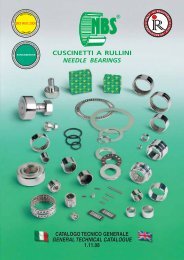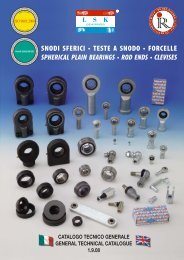ITC
ITC
ITC
You also want an ePaper? Increase the reach of your titles
YUMPU automatically turns print PDFs into web optimized ePapers that Google loves.
Applichiamo la formula: P = (2 x Q + q) x (L x RF) =<br />
dove RF = X x ––<br />
d<br />
+ –––<br />
2 y<br />
= 0,33 ––––<br />
38<br />
+ –––––––<br />
2 x 0,75<br />
= 0,1606<br />
D D 100 100<br />
P = (2 x 80 + 120) x (10 x 0,1606)<br />
P = (160 + 120) x (1,606)<br />
P = 280 x 1,606 = kg 449.<br />
Lo sforzo motore totale di trascinamento P1 sarà eguale<br />
a P maggiorato come abbiamo visto precedentemente<br />
delle resistenze passive.<br />
P1 x v”<br />
La potenza N da applicarsi, N = –––––––<br />
75<br />
La potenza ottenuta sarà maggiorata a seconda dei casi,<br />
(lunghezza del trasportatore, natura del carico e del sistema<br />
di carico) sino ad una volta e mezzo per tenere conto<br />
dell'eventuale maggiore sforzo per avviamento sotto carico.<br />
ESEMPIO N.3<br />
Trasportatore inclinato a tapparelle portanti il materiale.<br />
Distanza fra i centri degli assi di comando e di rinvio mt 50.<br />
Inclinazione 23°.<br />
Il peso Q del trasportatore a vuoto è, per mt 1 di kg 136.<br />
Il peso q dei materiale da trasportare è per mt 1 di kg 297.<br />
Le catene hanno dei rulli lubrificati del diametro di mm<br />
152.<br />
I detti rulli ruotano attorno a dei perni dei diametro di mm<br />
38.<br />
Quindi:<br />
L = 50 mt; α = 23°; sen 23° = 0,39; cos 23° = 0,92.<br />
Q kg 136; q = kg 297.<br />
RF = 0,20 x ––––<br />
38<br />
+ ––––––––<br />
2 x 0,75<br />
= 0,06.<br />
152 152<br />
Abbiamo tenuto X = 0,20 per rulli lubrificati.<br />
Applichiamo la formula:<br />
P = L (Q + q) x [(cos α RF) + sen α] + (Q x L)<br />
[(cos α x RF) – sen α].<br />
P = 50 x (136 + 297) x (0.92 x 0,06) + 0,39 + (136 x 50)<br />
x (0.92 x 0,06) - 0,39.<br />
P = 21.650 x (0,445) + 6.800 x (– 0,335).<br />
P = 9.634 – 2278 = 7356 kg che è lo sforzo periferico<br />
agente sulla circonferenza primitiva delle ruote di comando.<br />
Lo sforzo motore così determinato dovrà essere aumentato<br />
delle resistenze passive a seconda di quanto visti<br />
precedentemente, per ottenere P1.<br />
P1<br />
La potenza N da applicare in HP sarà: = ––––––––––<br />
x v”<br />
75<br />
Bisognerà inoltre maggiorare la potenza così ottenuta, a<br />
seconda dei casi, sino ad una volta e mezzo per tenere<br />
conto delle eventuali partenze sotto carico.<br />
Precisiamo per questo esempio che lo sforzo torcente o<br />
sforzo periferico sarà dunque in kg 7356. Mentre la tensione<br />
totale sulle catene kg 9634 (P + (L x 0) x sen oz) ossia<br />
(7356 + (50 x 136) x 0,39). Quella flettente per il calcolo<br />
degli assi sarà = a kg 11912 ossia 9634 + 2278.<br />
Anche per i calcoli dei trasportatori precedenti bisognerà<br />
procedere come sopra, sempre facendo attenzione,<br />
se il tratto di ritorno scende per semplice gravità<br />
o meno. Nell'esempio sopra elencato abbiamo aggiunto<br />
la tensione delle catene, appunto anche questo sforzo<br />
dato che l'inclinazione non era sufficiente a fare scendere<br />
il tratto di ritorno per semplice gravità.<br />
<strong>ITC</strong><br />
12<br />
The formula: P = (2 x Q + q) x (L x RF) = must be used<br />
where RF = X x ––<br />
d<br />
+ –––<br />
2 y<br />
= 0,33 ––––<br />
38<br />
+<br />
2<br />
–––––––<br />
x 0,75<br />
= 0,1606<br />
D D 100 100<br />
P = (2 x 80 + 120) x (10 x 0,1606)<br />
P = (160 + 120) x (1,606)<br />
P = 280 x 1,606 = kg 449.<br />
P1 total stress engine of dragging is equal to P increased<br />
by passive resistances.<br />
P1<br />
N. power to apply, N = –––––––<br />
x v”<br />
75<br />
The dotained power will be increased, case by case,<br />
(lenght of conveyor, kind of load and kind of loading system)<br />
up to 1 time and half to include possible greater stress in<br />
case of starting under load.<br />
EXAMPLE No 3<br />
Sliding flat top chain conveyor transporting material.<br />
Distance among centers of control axles and return 50<br />
mt., inclination 23°.<br />
The weight Q of an empty conveyor is for 1 mt of 136 kg.<br />
The weight q of stuff to transport is for 1 mt of 297 kg.<br />
Chains have lubricated roller of 152 mm. diameter. These<br />
rollers rotate round 38 mm. diam. pins.<br />
Therefore:<br />
L = 50 mt; α = 23°; sen 23° = 0,39; cos 23° = 0,92.<br />
Q kg 136; q = kg 297.<br />
RF = 0,20 x ––––<br />
38<br />
+ ––––––––<br />
2 x 0,75<br />
= 0,06.<br />
152 152<br />
Where X = 0,20 for lubricated rollers.<br />
The following formula has to be applied:<br />
P = L (Q + q) x [(cos α RF) + sen α] + (Q x L)<br />
[(cos α x RF) – sen α].<br />
P = 50 x (136 + 297) x (0.92 x 0,06) + 0,39 + (136 x 50)<br />
x (0.92 x 0,06) - 0,39.<br />
P = 21.650 x (0,445) + 6.800 x (– 0,335).<br />
P = 9.634 – 2278 = 7356 kg which is the peripheral stress<br />
acting on control wheels pitch line. The obtained engine<br />
stress has to be increased by passsive resistances, as<br />
seen before, to get P1.<br />
P1 x v”<br />
N power to apply in HP, will be: = ––––––––––<br />
75<br />
Moreover the obtained power will be increased, case by<br />
case, up to 1 time and half to include possible starting<br />
under load. For this example, the twisting stress or<br />
peripheral stress is in kg 7356. Total stretch on chains is<br />
9634 kg. (P + (L x 0) x sine oz) that is (7356 + (50 x 136)<br />
x 0,39).<br />
The bending tension of axles will be = 11912 kg whereos<br />
9634 + 2278.<br />
For calculations of previous conceyors, we have to proceed<br />
as above, important is to pay particular attention to way<br />
of returning section: if this descends for gravity or other.<br />
In our example; in fact, we had to add a further stress: the<br />
chains tension: the inclination wasn’t enough to enable<br />
the returning section to descend for simple gravity.





